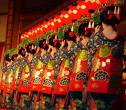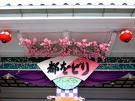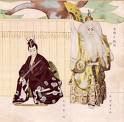[ . BACK to WORLDKIGO TOP . ]
:::::::::::::::::::::::::::::::::::::::::::::::::::::::::::::::::::::::::::::::::::::::::::::::::::
sumi temae, sumetemae 炭点前 Charcoal Setting
More about Ashes in Japanese Culture
***** Location: Japan
***** Season: Non-Seasonal Topic
***** Category: Humanity
*****************************
Explanation

In the Tea Ceremony school of
Yabunouchi, the five senses are entertained. With the ceremony of laying out the charcoal for boiling the water, the master and the guests gather at the open fireplace and enjoy not only the different colors of the charcoal, but also the warmth of the embers.
The
ashes where the charcoal is placed are also layed out and forked into special patterns.
Before the coal is placed,the hearth is ritually cleansed
with a feather,
habooki 羽箒.

The coal is layed out in a special pattern. The pieces have various size, the biggest for holding the warmth during the whole ceremony, the smallest for picking up fire quickly and some long ones for transfer of the glow to the larger piece.
Some twigs of white charcoal are also use, they make a fine decoration to enjoy with the eyes. The faint clicking of the burning embers is a joy for the ears.
After laying out the coals, the meal is served and then after a pause, the tea is served.
Just watching the arrangement and seeing the embers, feeling the warmth, makes the heart quiet and brings enjoyment to the group.
 White charcoal branches
White charcoal branches
xxxxxxxxxxxxxxxxxxxxxxxxxxxxx
first ritual layout of the coal, shozumi 初炭
replenishing the charcoal, gozumi 後炭
Here the master can show his skills, since the coals burn different at any time.
Click HERE for some photos !
External LINK
Sumi Temae Utensils
:::::::::::::::::::::::::::::::::::::::::::::::::::::::::::::::::::::::::::::::::::::::::::::::::::::
quote
The tea ceremony as an art form cuts through a whole spectrum of Japanese culture because it embraces many art forms such as architecture, gardening, ceramics, textiles, Japanese calligraphy, flower arrangement, and Japanese cuisine, plus a few rather arcane art forms such as the
sculpting of ashes and the building of a beautiful fire. Certain arrangements of ashes on which charcoal is placed can take as long as two hours to prepare. Other than the Japanese tea ceremony, where else can you find humble ashes raised to such a level of refinement and beauty?
Indeed, they are the finest ashes in the world. A story is told about three tea masters who had a magnificent tea room with much valuable equipment. One day the house caught fire and the 3 tea masters rushed in to save what they could.
The first thing they saved was the ashes!
The point being made with this story is that everything involved in a tea ceremony has been given careful aesthetic attention, even the ashes.
source : www.chinatownconnection.com
:::::::::::::::::::::::::::::::::::::::::::::::::::::::::::::::::::::::::::::::::::::::::::::::::::::
kigo for all winter
. sumi 炭 (すみ) charcoal
binchootan 備長炭 binchotan charcoal and more
.................................................................................
observance kigo for the New Year
suminuri 墨塗, 墨塗り (すみぬり)
painting the face with charcoal
Date no suminuri 伊達の墨塗 (だてのすみぬり)
..... sumitsuke shoogatsu 墨付正月(すみつけしょうがつ)墨付け正月
"New Year with charcoal painting"
 source : www.jwn.ne.jp
source : www.jwn.ne.jp
On January 15.
People paint their faces black and pray for health. Especially in Niigata at Tokamachi town.
There it happens after the ritual of throwing young husbands of the last year down the slope of the tempel Yakushi-Do (mukonage 婿投).
新潟県十日町市
It is also common in other parts of Tohoku, expecially the Date region of Fukushima.
SAIJIKI – NEW YEAR OBSERVANCES
:::::::::::::::::::::::::::::::::::::::::::::::::::::::::::::::::::::::::::::::::::::::::::::::::::::
:::::::::::::::::::::::::::::::::::::::::::::::::::::::::::::::::::::::::::::::::::::::::::::::::::::
topic for haiku
hai 灰 ash, ashes
Used just like that, the word is not a kigo and can apply to various kinds of ashes, see quote below.
But there are some compounds with it as kigo.
.................................................................................
. Ash Wednesday . Aschermittwoch
kigo for early spring
hai no suiyoobi 灰の水曜日 (はいのすいようび)
seikaisai 聖灰祭(せいかいさい)
daisaishibi 大斎始日(だいさいしび)
. kairobai 懐炉灰(かいろばい)ashes from the pocket heater
kigo for all winter
:::::::::::::::::::::::::::::::::::::::::::::::::::::::::::::::::::::::::::::::::::::::::::::::::::::
In Japan, most dead bodies are cremated and the ashes toghether with some bones are handed over to the family members.
They are kept in special "bone containers" (kotsutsubo 骨壷) and placed on the family altar at home or in a grave.
. . . CLICK here for Photos !
:::::::::::::::::::::::::::::::::::::::::::::::::::::::::::::::::::::::::::::::::::::::::::::::::::::
quote
The solid remains of fires, such as:
Cigar ash, the ash produced when a cigar is smoked
Wood ash, products of wood combustion
Incinerator bottom ash, a form of ash produced in incineration facilities
Volcanic ash, material ejected from the top of a volcano
Fly ash and bottom ash, products of coal combustion
Ash (analytical chemistry), the compounds that remain after a scientific sample is burned.
© More in the WIKIPEDIA !
The
volcanic ashes (kazanbai 火山灰) that are regularly raining from the volcano Sakurajima (Kagoshima) are called
yona よな.
:::::::::::::::::::::::::::::::::::::::::::::::::::::::::::::::::::::::::::::::::::::::::::::::::::::::::::::::::::::::::::
- Let us take a time trip to Edo !
. Recycling and Reuse in Edo - リサイクル と 再生 .
 haikai 灰買い buying ashes
haikai 灰買い buying ashes
Wood and straw was the most common burnable material in Edo. Considering there were about 1.000.000 people living in the city, a lot of ashes were produced every day.
Ashes were used in many ways during the Edo period. Some examples are the indigo dyers, paper makers, sake and silk producers, furniture makers and others.
Furniture makers used it especially for cleaning a surface.
The buyers for ashes of the kitchen fires and hibatchi heaters walked around the cities and then sold their ware at special "ash markets", for example in Kawagoe and in the suburbs of Edo.
In Kabuki there is a famous saying, to express the "most trivial things"
kamado no shita no hai made 竈の下の灰まで
even the ashes from below the stove
In Kyoto and Osaka the people really sold the ashes from below the stove, sometimes with some husks of rice (nuka) or seeds of cotton (tane), so the buyers would call out
nuka tane hai wa gozai 「ぬか・たね・はいはござい」
In Edo, the ash buyers wanted only the pure ashes. They brought their merchandise to a special ash dealer or merchand 灰問屋 (
haidonya), got their money and spent the rest of the day happily.
灰問屋みな白髪の若い者
haidonya mina shiraga no wakai mono
the ash merchands
are all white-haired
young men
. senryu, senryū 川柳 Senryu in Edo .
One of the rich ash merchands was Haiya Juuyuu 灰屋紹由
Haiya Juyu.
Most ash buyers carried a shoulder pole with two rope baskets with long lines at the four corners, (see above),
others teamed up and shared the burden of the basket, called
-
mokko モッコ / もっこ / 畚
 *****************************
Worldwide use
*****************************
*****************************
Worldwide use
*****************************
Things found on the way
 Ashes and the Way of Incense (koodoo, kodo 香道)
Ashes and the Way of Incense (koodoo, kodo 香道)
. . . CLICK here for Photos of Ashes !
Usually, unperfumed rice-ash is used. It is carefully layered and finally raked into patterns 灰の模様, (hashime 箸目) sometimes a different one for each month. There are special tools to rake patterns into the ashes.
. . . CLICK here for Photos !

There is one opening
kikisuji 聞筋〈ききすじ〉
The ashes can be divided into six fields or three fields in the form of the letter V.
 ember pot
- Reference -
ember pot
- Reference -
koorobai 香炉灰 ash for the incense burner
. . . CLICK here for Photos !
white ash for
soradaki 空薫(そらだき) "burning for pleasure"
. . . CLICK here for Photos !
tadon たどん【炭団】
charcoal briquette
They are made from coal powder of wood or bamboo, kneaded with natural glue from seaweed (funori) . After forming the balls they are dried. When carrying normal charcoal in bundles, there is always a lot of powder at the bottom of the package, which was used to make the balls.
They are now so powerful as heating material, but keep burning for a long time.
In the Edo period, Shiobara Tasuke 塩原太助 mixed them with glue from seaweed to make them even more useful.
Starch from potatoes was also used to stick the bits and pieces and powder together.
Before the advent of heating oil they were use for heating and in cooking stoves and hibachi.
Charcoal balls used for Kodo 香道, the way of fragrance, are made from expensive wood charcoal powder and rolled into longer sticks. They are quite different from the tadon for heating.
Since they are black, they are a symbol for loosing a bout in sumo (kuroboshi 黒星).
Incense and Daruma
*****************************
HAIKU
 わが春やたどん一つに小菜一把
わが春やたどん一つに小菜一把
waga haru ya tadon hitotsu ni ona ichi wa
my spring--
one charcoal ball
and a bundle of greens
Kobayashi Issa
Tr. David Lanoue
::::::::::::::::::::::::::::::::::::::::::::::::::::::::::::::::::::::::::::::::::::::::::::::::::
 source : xxx
source : xxx
「茶の湯日々草」 「炭手前の図」
sumi temae
水野年方 - 1896
setting the charcoal -
we look and listen,
warming the heart
tea ceremony -
wispering charcoals
warm the heart
Gabi Greve, March 2007
:::::::::::::::::::::::::::::::::::::::::::::::::::::::::::::::::::::::::::::::::::::::::::::::::::::
Tea Ceremony Haiku
. Matsuo Basho 松尾芭蕉 - Archives of the WKD .

four and a half tatami was a standard size of a room for the tea ceremony.
秋近き心の寄るや四畳半
aki chikaki kokoro no yoru ya yojoohan
as autumn approaches
our hearts are drawn together--
a four-and-a-half mat room
tr. Barnhill
Autumn is near;
The heart inclines
To the four-and-a-half mat room.
tr. Blyth
sensing autumn's approach
four hearts draw together
in a small tea room
tr. Ueda
Written on the 21st day of the 6th lunar month, 1694
元禄7年6月21日, Basho age 51
when Basho stayed at the estate of Bokusetsu 木節.
The members of this meeting were three good friends, trying to console Basho, who had on the 8th day just gotten the news of the death of his wive/lover
. Juteini 寿貞尼 Jutei-Ni .
Apart from Basho and Bokusetsu, the two other participants sharing the tea room were
. Hirose Izen 広瀬維然 .
. Kagami Shikoo 各務支考 Kagami Shiko .
Later in the 7th lunar month, Basho wrote another hokku at the estate of Bokusetsu (Kibushi):
ひやひやと壁をふまえて昼寝哉
hiya hiya to kabe o fumaete hirune kana
Mochizuki Bokusetsu 望月木節
(? 1964, 11th lunar month)
A doctor from Otsu, also known under the name of 是好.
He was one of the few who saw Basho on his death bed.
*****************************
Related words
*****
Yabu no Uchi Tea Ceremony Part 1
*****
Tea Ceremony Saijiki 茶道の歳時記
chashitsu 茶室 Tea Ceremony Room.
*****
. Forest work in all seasons
making charcoal
*****
. Fire (kaji)Worldwide. Bushfire, wildfire
after a fire, there are ashes on the ground.
:::::::::::::::::::::::::::::::::::::::::::::::::::::::::::::::::::::::::::::::::::::::::::::::::::::
[ . BACK to DARUMA MUSEUM TOP . ]
[ . BACK to WORLDKIGO . TOP . ]
- #sumitemae -
:::::::::::::::::::::::::::::::::::::::::::::::::::::::::::::::::::::::::::::::::::::::::::::::::::::
 Siddhārtha Gautama, in Sanskrit, or Siddhattha Gotama, in Pali, was a spiritual teacher from ancient India and the founder of Buddhism.
Siddhārtha Gautama, in Sanskrit, or Siddhattha Gotama, in Pali, was a spiritual teacher from ancient India and the founder of Buddhism.
















































